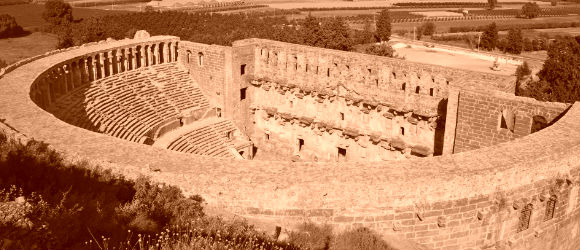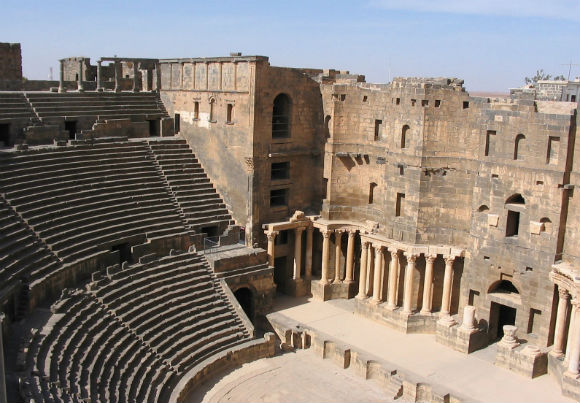Aspendos was an ancient Greco-Roman city in Antalya province of Turkey. It is located 7 kilometres (4.3 mi) northeast of central Serik.
Aspendos was an ancient city in Pamphylia, Asia Minor, located about 40 km east of the modern city of Antalya, Turkey. It was situated on the Eurymedon River about 16 km inland from the Mediterranean Sea; it shared a border with, and was hostile to, Side. According to later tradition, the (originally non-Greek) city was founded around 1000 BC by Greeks who may have come from Argos. The wide range of its coinage throughout the ancient world indicates that, in the 5th century BC, Aspendos had become the most important city in Pamphylia. At that time the Eurymedon River was navigable as far as Aspendos, and the city derived great wealth from a trade in salt, oil, and wool.
Aspendos did not play an important role in antiquity as a political force. Its political history during the colonization period corresponded to the currents of the Pamphylian region. Within this trend, after the colonial period, it remained for a time under Lycian hegemony. In 546 B.C. it came under Persian domination. The face that the city continued to mint coins in its own name, however, indicates that it had a great deal of freedom even under the Persians.
In 467 B.C. the statesman and military commander Cimon, and his fleet of 200 ships, destroyed the Persian navy based at the mouth of the river Eurymedon in a surprise attack. In order to crush to Persian land forces, he tricked the Persians by sending his best fighters to shore wearing the garments of the hostages he had seized earlier. When they saw these men, the Persians thought that they were compatriots freed by the enemy and arranged festivities in celebration. Taking advantage of this, Cimon landed and annihilated the Persians. Aspendos then became a member of the Attic-Delos Maritime league.
The Persians captured the city again in 411 B.C. and used it as a base. In 389 B.C. the commander of Athens, in an effort to regain some of the prestige that city had lost in the Peloponnesian Wars, anchored off the coast of Aspendos in an effort to secure its surrender. Hoping to avoid a new war, the people of Aspendos collected money among themselves and gave it to the commander, entreating him to retreat without causing any damage. Even though he took the money, he had his men trample all the crops in the fields. Enraged, the Aspendians stabbed and killed the Athenian commander in his tent.
When Alexander the Great marched into Aspendos in 333 B.C. after capturing Perge, the citizens sent envoys to him to request that he would not establish that he be given the taxes and horses that they had formerly paid as tribute to the Persian king. After reaching this agreement. Alexander went to Side, leaving a garrison there on the city’s surrender. Going back through Sillyon, he learned that the Aspendians had failed to ratify the agreement their envoys had proposed and were preparing to defend themselves. Alexander marched to the city immediately. When they saw Alexander returning with his troops, the Aspendians, who had retreated to their acropolis, again sent envoys to sue for peace. This time, however, they had to agree to very harsh terms; a Macedonian garrison would remain in the city and 100 gold talents as well as 4.000 horses would be given in tax annually.
In 190 BC the city surrendered to the Romans, who later pillaged it of its artistic treasures. Toward the end of the Roman period the city began a decline that continued throughout Byzantine times.
Aspendos,



There are plenty of Theaters of Dionysus in this part of the world, but this one in Aspendos is remarkably preserved. It also has great acoustics, so join a few friends and sing a song from the stage. Photographers will love the curving lines of the seating plus the arch covered walkways at the top. Best to go early or…
It's a good place for a half day walk, very beautiful nature and surroundings.
I would advice to wear comfortable footwear and clothes
Thıs place ıs amazıng, Just don't limit yourself to the theatre as there is so much to see outside of it.
There is still a good bit of the aqueduct, the fountain,shops,church and a street to see, as well as the view from the top.
there are plenty of signs and also one with an overall view so you know…
The Aspendos Theatre is well preserved and large but its design feels quite intimate. When we visited they were setting up for an opera performance with a large stage in place – this did not detract but rather enhanced our experience as it was easier to imagine the theatre operating in Roman times. If I had the opportunity I would…
Uninspiring from the outside but a definite wow factor when entering the arena – we hadn't researched the amphitheatre before going and were amazed at how complete the structure is. Visiting in November meant that there were not many people around and we explored the site thoroughly. Excellent local guides and information available – lots of parking, a good shop…
condition is very good, not to expensive, beautiful
we got there from Antalya by taxi.
we paid for Aspendos and Perge 40 euro (-after handling the price. normal price for Aspendos was 65 euro and for Perge 35 euro)
probably you can get it for less.
entrance ticket 15 Tl (we could pay with bank card)
the amphitheatre is very nice and in a very good condition (during…
We had a lovely time here, it is the best perversed Roman Theatre in the world, it was only ever used for drama. Go with a guide to get the maxium out of the trip, compared with how busy some attractions get this so quiet.
Avoid the people selling things outside, they were a complete rip off, they wanted €1…
I was very pleased with my decision to visit Aspendos.It is very well preserved and you can go right up to the top if you are good on your legs,its worth a visit for people who are interested in culture like me and my husband.
aspendos is a very well preserved theatre it s a must do if u re travelling to antalya and it s not far.if there s no car available many touristic buses organise almost avery day tour to aspendos